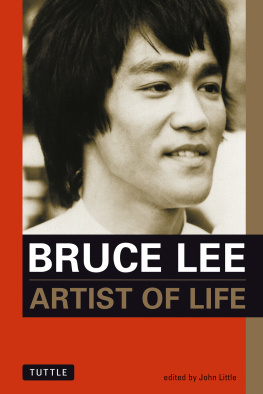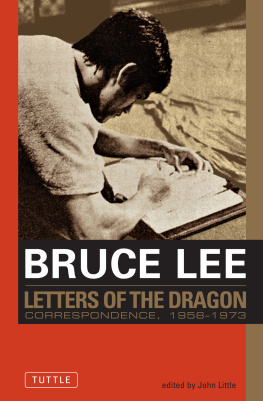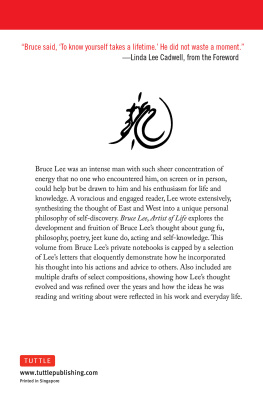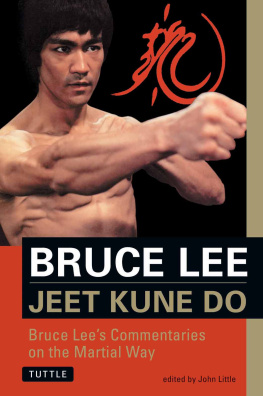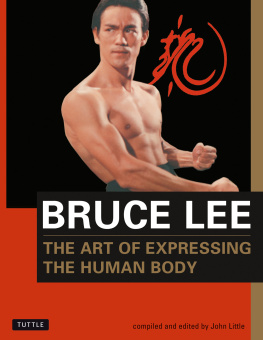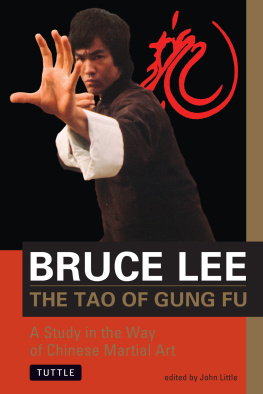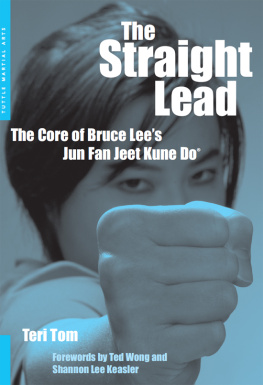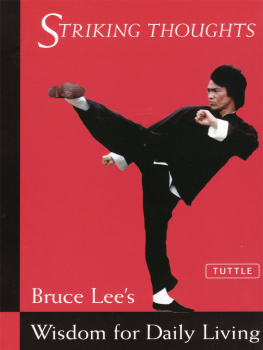The family of Bruce Lee wishes to acknowledge:
The dedication of John Little, whose passion for the art and philosophy of Bruce Lee has inspired this publication, and who has spent hours researching, studying, annotating, and organizing Bruces prolific writings, photos, and memorabilia and gathering the recollection of friends and students.
And, Adrian Marshall, attorney for the estate of Bruce Lee for nearly thirty years, who, with caring attention to the best interests of his friend Bruce lee, has been instrumental in the publication of this series.
Part 1
G UNG F U


When Bruce Lee returned to the land of his birth (America) from Hong Kong at the age of eighteen, be brought with him a vision of introducing the then little-known cultural art of Chinese gung fu to America.
Lee had at one time actually envisioned establishing chains of gung fu institutes all across America. However, as his knowledge expanded with age, and with it his philosophic and martial experiences, he no longer felt the need to extol the virtues of traditionhowever venerated.
This is not to suggest that Lee ever abandoned his Chinese heritage and philosophy; he simply over time came to look for the common root of humanity, as opposed to nationality, to justify his belief system and actions. Even so, it is interesting to note that when he began to take control over the philosophy content of his films in 1972, the lessons he revealed were gleaned from the Eastern traditions.
These essays, dealing extensively with Chinese philosophy and martial art were written in the early 1960s. There are a wonderful reflection of a young Bruce Lees driving passion to introduce and share with Westerners the beauty of his Chinese culture.
1-A
THE TAO OF GUNG FU: A STUDY IN THE WAY OF THE CHINESE MARTIAL ART
Gung fu is a special kind of skill, a fine art rather than just a physical exercise or self-defense. To the Chinese, gung fu is the subtle art of matching the essence of the mind to that of the techniques in which it has to work. The principle of gung fu is not a thing that can be learned, like a science, by fact-finding or instruction in facts. It has to grow spontaneously, like a flower, in a mind free from desires and emotions. The core of this principle of gung fu is Tao the spontaneity of the universe.
The word Tao has no exact equivalent in the English language. To render it into the Way, or the principle or the law is to give it too narrow an interpretation. Lao-tzu, the founder of Taosim, described Tao in the following words:
The Way that can be expressed in words is not the eternal Way; the Name that can be uttered is not the eternal Name. Conceived of as nameless it is the cause of Heaven and earth. Conceived of as having a name it is the mother of all things. Only the man eternally free from passion can contemplate its spiritual essence. He who is clogged by desires can see no more than its outer form. These two things, the spiritual (Yin) and the material (Yang), though we call them by different names, are one and the same in their origin. The sameness is a mystery of the mysteries. It is the gate of all that is subtle and wonderful.
In Masterpieces of World Philosophy: Tao is the nameless beginning of things, the universal principle underlying everything, the supreme, ultimate pattern, and the principle of growth.
Although no one word can substitute its meaning, I have used the word Truth for itthe Truth behind gung fu; the Truth that every gung fu practitioner should follow.
Tao operates in Yin and Yang, a pair of mutually complementary forces that are at work in and behind all phenomena. This principle of Yin-Yang, also known as Tai Chi, is the basic structure of gung fu. The Tai Chi, or Grand Terminus, was first drawn more than three thousand years ago by Chou Chun I.
The Yang (whiteness) principle represents positiveness, firmness, masculinity, substantiality, brightness, day, heat, and so forth. The Yin (blackness) principle is the opposite. It represents negativeness, softness, femininity, insubstantiality, darkness, night, coldness, and so forth. The basic theory in Tai Chi is that nothing is so permanent as never to change. In other words, when activity (Yang) reaches the extreme point, it becomes inactivity, and inactivity forms Yin. Extreme inactivity returns to become activity, which is Yang. Activity is the cause of inactivity and vice versa. This system of complementary increasing and decreasing of the principle is continuous. From this one can see that the two forces (Yin-Yang), although they appear to conflict, in reality are mutually interdependent; instead of opposition, there is cooperation and alternation.
The application of the principles of Yin-Yang in gung fu are expressed as the Law of Harmony. It states that one should be in harmony with, not in rebellion against, the strength and force of the opposition. This means that one should do nothing that is not natural or spontaneous; the important thing is not to strain in any way. When opponent A uses strength (Yang) on B, B must not resist him (back) with strength; in other words, B does not use positiveness (Yang) against positiveness (Yang), but instead yields to A with softness (Yin) and leads A in the direction of his own force, negativeness (Yin) to positiveness (Yang). When As strength goes to the extreme, the positiveness (Yang) will change to negativeness (Yin), and B can then take him at his unguarded moment and attack with force (Yang). Thus the whole process is not unnatural or strained; B fits his movement harmoniously and continuously into that of A without resisting or striving.
The above idea gives rise to a closely related law, the Law of Noninterference with Nature, which teaches a gung fu man to forget about himself and follow his opponent (strength) instead of himself; he does not move ahead but responds to the fitting influence. The basic idea is to defeat the opponent by yielding to him and using his own strength. That is why a gung fu man never asserts himself against his opponent, and never puts himself in frontal opposition to the direction of his opponents force. When being attacked, he will not resist, but will control the attack by swinging with it. This law illustrates the principles of nonresistance and nonviolence, which were founded on the idea that the branches of a fir tree snap under the weight of the snow, while the simple reeds, weaker but more supple, can overcome it. In the IChing, Confucius illustrated this: To stand in the stream is a datum of nature; one must follow and flow with it. In the Tao Teh Ching, the gospel of Taoism, Lao-tzu pointed out to us the value of gentleness. Contrary to common belief, the Yin principle, as softness and pliableness, is to be associated with life and survival. Because he can yield, a man can survive. In contrast, the Yang principle, which is assumed to be rigorous and hard, makes a man break under pressure (note the last two lines, which make a fair description of revolution as many generations of people have seen it):
Alive, a man is supple, soft;
In death, unbending, rigorous.
All creatures, grass and trees, alive
Are plastic but are pliant too,
And dead, are friable and dry.
Unbending rigor is the mate of death,
And yielding softness, company of life;
Unbending soldiers get no victories;
The stiffest tree is readiest for the ax.
The strong and mighty topple from their place;

